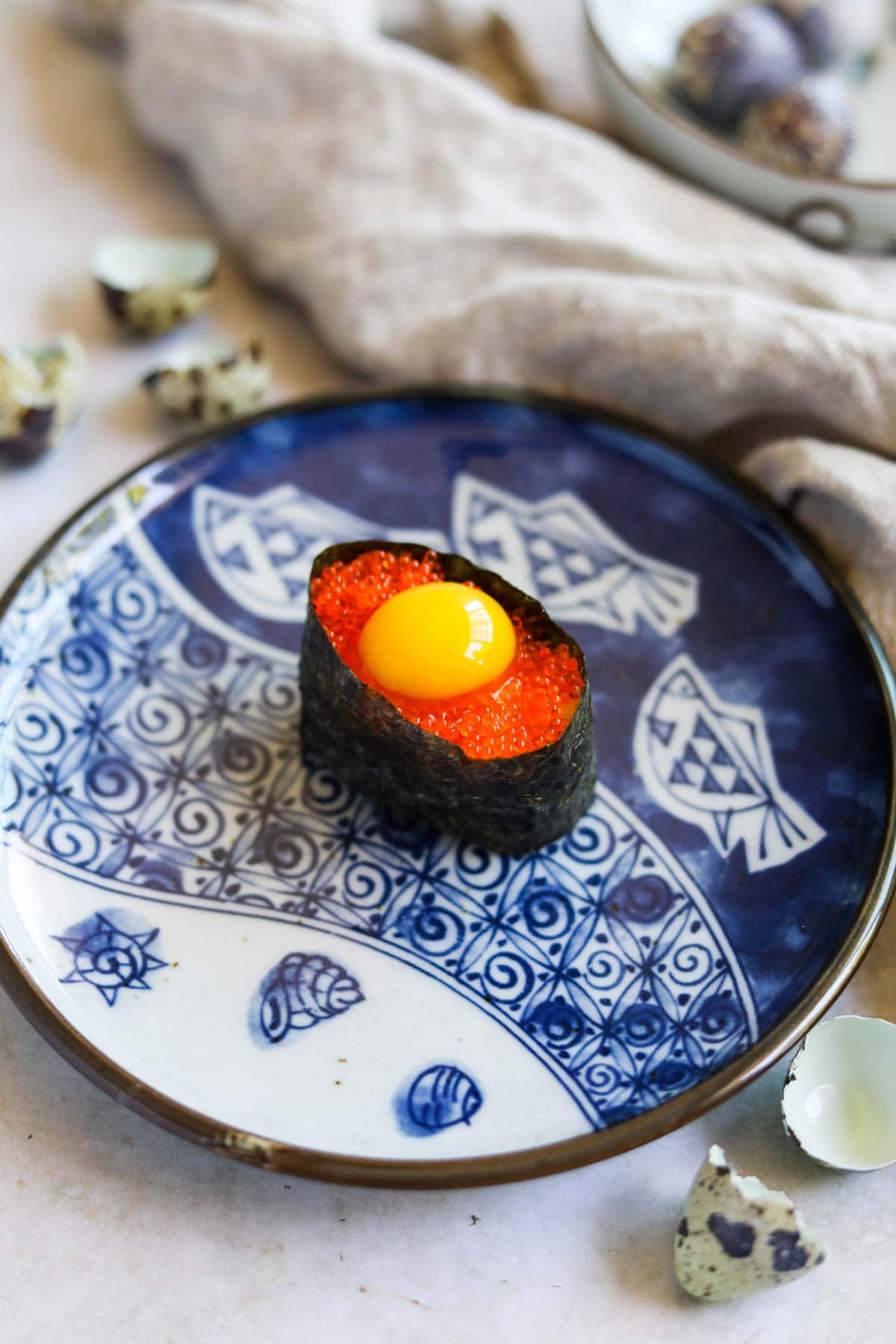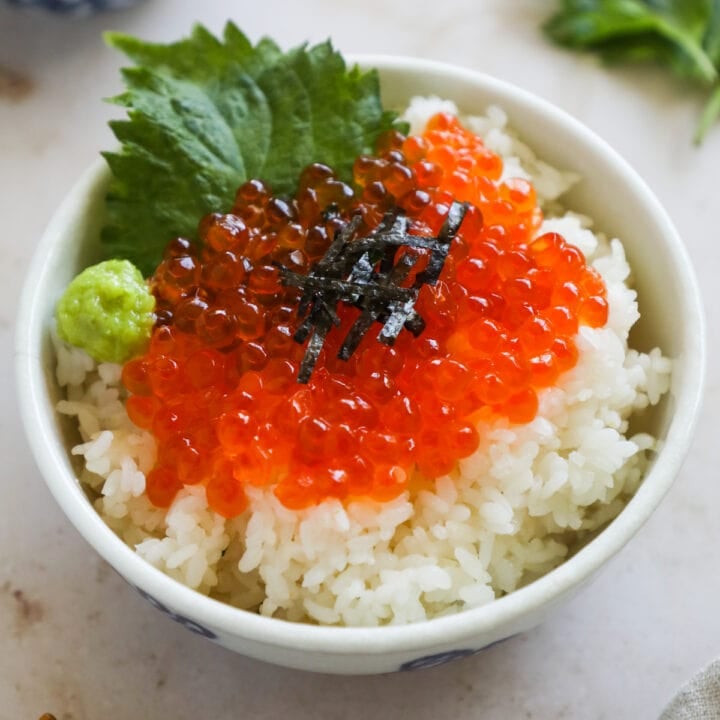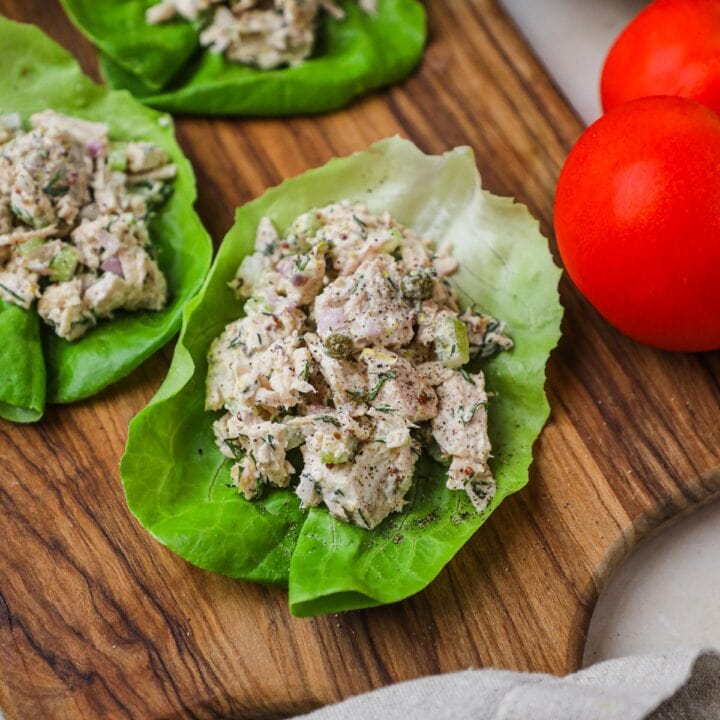Tobiko Gunkan is a decadent sushi featuring seasoned sushi rice wrapped in a strip of nori and topped with tobiko and a quail egg. This restaurant-quality sushi comes together in minutes and will wow your friends and family at your next sushi night at home!

Tobiko gunkan maki is a delicious blend of umami ocean flavors and rich yolk. The tobiko (とびこ), or flying fish roe, has a crunchy texture and the nori offers a hint of ocean flavor. The seasoned rice cleans your palate and the quail egg adds a rich flavor that ties the ingredients together. This sushi looks impressive and is incredibly easy to assemble.
Have a sushi night at home and serve this roll with some of our favorite dishes, including Eel Hand Roll, Spicy Crab Roll, Crunchy California Sushi Roll, Miso Salmon Carpaccio, and How to Make Kani Salad. Serve with a side of pickled ginger, wasabi, and soy sauce for even more flavor!
Jump to:
About Tobiko Sushi
- Taste - The briny fish roe combines with the rich quail egg yolk for a uniquely delicious combination. The neutral rice balances the decadent flavors.
- Texture - The tobiko is soft with a slight bite, the egg yolk is gooey, the rice is firm, and the nori adds a light crunch.
- Effort - This roll only requires basic sushi skills to make.
- Time - It takes about a half hour to cook the rice then another 15-20 minutes to prepare the ingredients and assemble the roll. As you get better at making sushi, the time it takes to assemble will decrease.
What is Tobiko?
Tobiko is a bright orange and bead-shaped Japanese delicacy. It is made of raw flying fish roe (eggs) and is often enjoyed in gunkan maki (sushi) or as garnish for other sushi rolls. It has a briny and slightly sweet taste.
What is Gunkan maki?
Gunkan maki is a type of Japanese sushi roll. The roll is small, wrapped in nori, and shaped like a boat. Since the roll is boat shaped, they are called gunkan, which means battleship in Japanese. Gunkan sushi usually features tobiko, ikura, or uni (in addition to the rice and nori). In our recipe, we add quail egg for extra flavor.
Ingredients

- Japanese short grain rice - Japanese short grain rice is best for sushi because it is both sticky and fluffy enough to retain its shape.
- Seasoned rice vinegar (sushi vinegar) - Seasoned rice vinegar is added to white rice to make sushi rice. The vinegar adds a lightly sweet and tart flavor. If you don't have seasoned rice vinegar, simmer regular rice vinegar with a pinch of sugar and salt in a saucepan until the sugar and salt dissolve. Allow to cool then use per the recipe instructions.
- Nori seaweed sheets - Nori is dried Japanese seaweed used to wrap and keep the rice and filling together. Nori sheets also tastes delicious with the other ingredients.
- Tobiko - Tobiko is flying fish roe. It is a Japanese delicacy and has a unique briny and smoky flavor.
- Quail eggs - Quail eggs taste similar to regular eggs, but have a slightly more delicate yolk and egg white.
See recipe card for quantities.
Substitutions
- Ikura (salmon roe) - Ikura tastes similar to tobiko but is slightly less sweet.
- Masago (capelin roe) - Masago roe is milder than flying fish roe, has a finer texture, and is slightly cheaper.
- Black tobiko - This type of roe is one of many different colors of tobiko. Its black color comes from squid ink.
- Green tobiko - Green tobiko is dyed with wasabi.
- Yellow tobiko - Yellow tobiko is dyed with yuzu (a fragrant citrus fruit).
- Red tobiko - Red tobiko is colored from beet juice.
Variations
- No quail egg - Omit the quail egg to enjoy the pure flavor of the tobiko.
- Hand roll or sushi roll - Enjoy roe as a topping on a hand roll or other types of sushi rolls.
- Tobiko donburi - If you really love tobiko, enjoy it in a donburi or as a donburi topping (replace ikura with tobiko or add it in each recipe).
Instructions

Rice
- Prepare rice - Prepare rice per the below stovetop or rice cooker instructions. Transfer rice to a bowl and season with seasoned rice vinegar. Fluff and fan the rice until cool. (Photo 1 and 2)
- Cut nori - Cut nori into 6 approximately 1x7-inch strips. Most nori sheets are perforated and can be easily cut into strips.
- Wet hands - Keep a bowl of water next to your sushi making station to keep your hands wet. This prevents the rice from sticking to your hands. Wet your hands in the bowl of water and put about 2 tablespoons of rice in your hands. (Photo 4)

Assemble Tobiko Sushi
- Form rice - Use the palm of your hand to gently form the rice into an oval shape. Squeeze the rice gently just so the rice sticks together but is not mushy. Use your fingers on the opposite hand to form the rice, as shown in the photos above. (Photo 5)
- Wrap the rice - Place the formed rice on a clean surface. Take a strip of nori and wrap it around the perimeter of one of the rice ovals. Use a single grain of rice as “glue” to seal the tail of the nori strip. Repeat steps on the remaining rice ovals to form 6 gunkan, or battleships. (Photo 6, 7, and 8)

- Fill the gunkan - Fill the top of the gunkan pieces with roe and carefully create a small well in the middle. Crack the quail eggs and place one in each tobiko well. Serve with soy sauce and wasabi if desired. (Photo 9, 10, and 11)
Pro tip: If you are having a hard time getting the nori to stick to itself when you roll the sushi, you can smash a few more grains of rice where the nori needs to stick to itself.
What to Serve with Gunkan Sushi
This tobiko flying fish roe recipe is a rich and flavorful appetizer. Typically, we enjoy it with an Unagi Hand Roll, a Spicy Kani Roll, or Hamachi Crudo. If we want a more filling meal, we enjoy it as an appetizer for Japanese Chicken Cutlet or Shrimp Tempura Udon.
FAQ
You can buy the ingredients at Japanese markets, like Mitsuwa or Nijiya, or some common chain grocery stores.
Yes, according to medical news today, tobiko eggs are high in proteins, omega-3 fatty acids, and other nutrients. Also, a study from the Journal of Food Science and Technology notes that the fat in roe can improve learning abilities.
If unopened, it can last 4-6 weeks in the refrigerator. Once opened, you need to eat it within 5 days. You can also freeze unopened tobiko for up to 6 months.
Tobiko is flying fish roe (eggs) while masago is capelin roe. Masago is finer with a brighter orange color while tobiko is slightly more red. With regard to flavor, they are similar, but masago is slightly milder.
Ikura is salmon roe and is slightly larger than tobiko. Tobiko is also a little sweeter than ikura.

Storage
Tobiko gunkan is best enjoyed immediately if the quail egg is already on top or within 1 day of making if the egg has not been added. Store it in an air-tight container in the refrigerator. The key is to keep the moisture locked in so the roll doesn't dry out. This tobiko roll does not stand up well to freezing.
Top tips
- When you are cooking the rice, make sure you don't add too much water or the rice will become mushy (we want it firm).
- Be careful to not overcook the rice or it will be hard and not pliable enough for sushi.
- Be sure to let the rice cool before using it, or it will become rubbery on the nori.
- If you are using a rice cooker and the outside of the rice gets crispy or hard, use a fork to fluff the rice and add moisture back into those crispy bits.
Related Japanese Recipes
Did You Like this Recipe?
Love this gunkan recipe? Please leave a 5-star rating in the recipe card below and leave a comment below. Thanks!
Sign up for THP's newsletter and keep in touch on Instagram, Facebook, Pinterest, TikTok, and YouTube. If you make this recipe, tag #theheirloompantry so we can see your tobiko quail egg gunkan!
📖 Recipe
Tobiko Gunkan Sushi
Equipment
Ingredients
- ½ cup uncooked Japanese short grain rice
- ⅔ cups filtered water
- ½ tablespoon sushi vinegar
- 2 nori sheets cut into 6 approximately 1x7-inch strips
- 2 tablespoon tobiko divided
- 6 quail eggs
Instructions
Rice
- Stovetop instructions - Place rice in a saucepan and rinse the rice in the sink until the water runs clear, then drain. Combine washed rice and filtered water in a medium saucepan. Bring the rice to a low boil, then reduce the heat to low. Cover the pot and simmer for 20 minutes or until the water is absorbed. Remove from the heat and let sit covered for 10 minutes. Fluff the rice with a fork.½ cup uncooked Japanese short grain rice, ⅔ cups filtered water
- Rice cooker instructions - Place rice in the electric rice cooker pot and rinse the rice in the sink until the water runs clear, then drain. Combine rice and filtered water in the pot and cook per the rice cooker directions.½ cup uncooked Japanese short grain rice, ⅔ cups filtered water
- Make sushi rice - Transfer rice to a bowl and season with seasoned rice vinegar. Fluff and fan the rice until cool.½ tablespoon sushi vinegar
Tobiko Sushi
- Form rice - Keep a bowl of water next to your sushi making station to keep your hands wet. This prevents the rice from sticking to your hands. Wet your hands in the bowl of water and put about 2 tablespoons of rice in your hands. Use the palm of your hand to gently form the rice into an oval shape. Squeeze the rice gently just so the rice sticks together but is not mushy. Use your fingers on the opposite hand to form the rice, as shown in the photos above.
- Wrap the rice - Place the formed rice on a clean surface. Take a strip of nori and wrap it around the perimeter of one of the rice ovals. Use a single grain of rice as “glue” to seal the tail of the nori strip. Repeat steps on the remaining rice ovals to form 6 gunkan, or battleships.2 nori sheets
- Fill the gunkan - Fill the top of the gunkan sushi with tobiko and carefully create a small well in the middle. Crack the quail eggs and place one in each tobiko well. Serve with soy sauce and wasabi if desired.2 tablespoon tobiko, 6 quail eggs
Notes
- When you are cooking the rice, make sure you don't add too much water or the rice will become mushy (we want it firm).
- Be careful to not overcook the rice or it will be too hard and not pliable enough to use for sushi.
- Be sure to let the rice cool before using it, or it will become rubbery on the nori.
- If you are using a rice cooker and the outside of the rice gets crispy and hard, use a fork to fluff the rice and add moisture back into those crispy bits.
- If you don't have seasoned rice vinegar, simmer regular rice vinegar with a pinch of sugar and salt in a saucepan until the sugar and salt dissolve. Allow to cool then use per the recipe instructions.












Leave a Reply